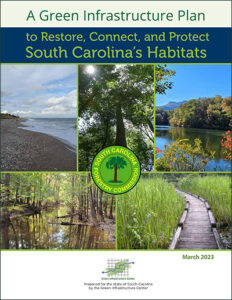 See the new priority habitat cores and corridors to support the state’s wildlife and outdoors. GIC built a statewide habitat model and maps all 10 planning regions. To stem the loss of South Carolina’s natural resources and to ensure that the landscape is resilient, the South Carolina Forest Commission and GIC launched a statewide strategic planning effort to map key, large habitat areas known as core habitats and to identify and plan for their connectivity. The more connected the landscape is, the more resilient it is to disturbance, since areas damaged by storms or floods can repopulate more quickly if species can reach these areas through natural landscape corridors. The statewide planning work has Project BackgroundThe GIC created a statewide map of large forest and wetland habitats in 2015, as well as a guide Evaluating and Conserving Green Infrastructure Across the Landscape: A Practitioner’s Guide1, which describes the importance of habitat cores and how to plan for their conservation. This report does not replace that guide. Those who wish to learn more about GI planning can obtain the free guide at the link below. This project is an update to the original map and a strategic plan for actions and strategies that South Carolina can employ to conserve its highest value landscapes for both wildlife and people. Since 2015, the landscape of South Carolina has changed as intact forested land cover has declined. In addition, more species are now at risk. For example, the U.S. Forest Service listed the Northern Long Eared bat as an endangered species in November 2022. This bat has mostly disappeared from the upstate but has been found in Charleston and Berkeley Counties, both of which are experiencing tremendous growth pressures, putting the bats at greater risk. To prioritize the landscapes to conserve for the future, GIC has created an updated resulted in this green infrastructure strategic plan, which provides new tools and planning strategies for use by state agencies and regional and local governments and conservation organizations to maximize landscape conservation and connectivity.
See the new priority habitat cores and corridors to support the state’s wildlife and outdoors. GIC built a statewide habitat model and maps all 10 planning regions. To stem the loss of South Carolina’s natural resources and to ensure that the landscape is resilient, the South Carolina Forest Commission and GIC launched a statewide strategic planning effort to map key, large habitat areas known as core habitats and to identify and plan for their connectivity. The more connected the landscape is, the more resilient it is to disturbance, since areas damaged by storms or floods can repopulate more quickly if species can reach these areas through natural landscape corridors. The statewide planning work has Project BackgroundThe GIC created a statewide map of large forest and wetland habitats in 2015, as well as a guide Evaluating and Conserving Green Infrastructure Across the Landscape: A Practitioner’s Guide1, which describes the importance of habitat cores and how to plan for their conservation. This report does not replace that guide. Those who wish to learn more about GI planning can obtain the free guide at the link below. This project is an update to the original map and a strategic plan for actions and strategies that South Carolina can employ to conserve its highest value landscapes for both wildlife and people. Since 2015, the landscape of South Carolina has changed as intact forested land cover has declined. In addition, more species are now at risk. For example, the U.S. Forest Service listed the Northern Long Eared bat as an endangered species in November 2022. This bat has mostly disappeared from the upstate but has been found in Charleston and Berkeley Counties, both of which are experiencing tremendous growth pressures, putting the bats at greater risk. To prioritize the landscapes to conserve for the future, GIC has created an updated resulted in this green infrastructure strategic plan, which provides new tools and planning strategies for use by state agencies and regional and local governments and conservation organizations to maximize landscape conservation and connectivity.
You can view or download the South Carolina Green Infrastructure Plan Report here.